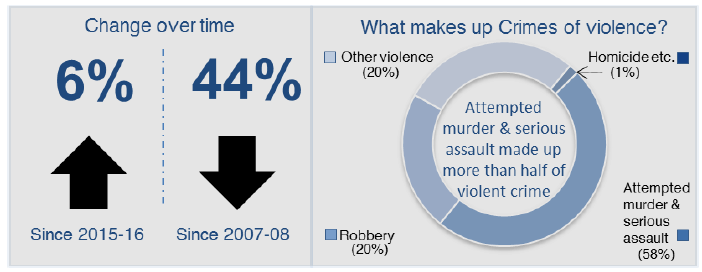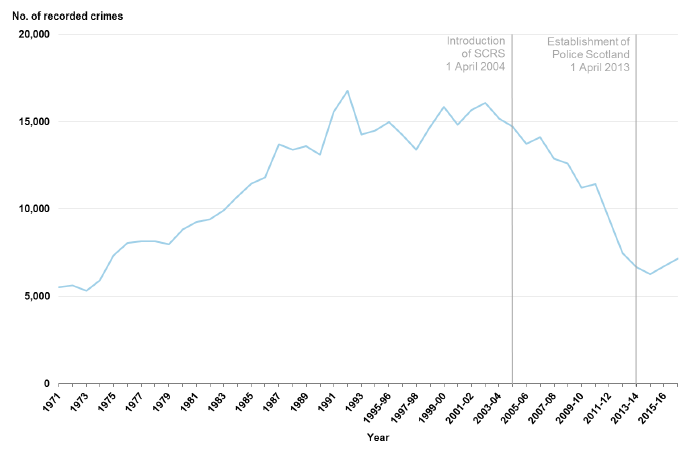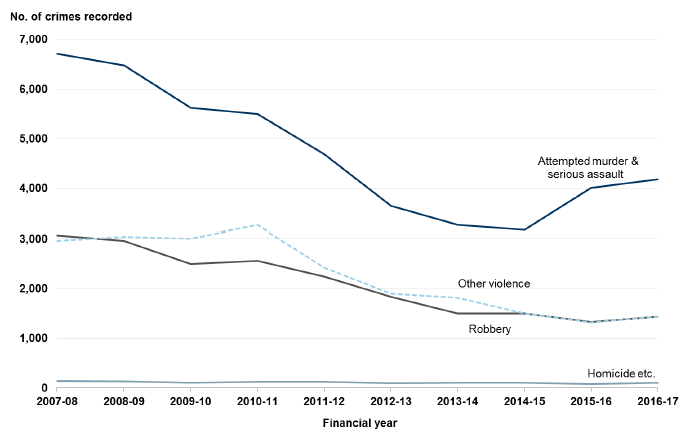Recorded crime in Scotland: 2016-2017
Statistics on crimes and offences recorded and cleared up by the police in Scotland, split by crime or offence group and by local authority.
This document is part of a collection
Group 1 – Non-sexual Crimes of Violence

Number of Non-sexual crimes of violence recorded in 2016-17:
Non-sexual crimes of violence account for 3% of all crimes recorded in Scotland in 2016-17. Between 2015-16 and 2016-17, the number of Non-sexual crimes of violence recorded by the police in Scotland increased by 6%, from 6,737 to 7,164.
Chart 6 below shows the number of Non-sexual crimes of violence from 1971 onwards. Levels of violent crime increased for a long period, before entering a downward trend in 2002-03, however there have been increases in the last two years. Despite this the number of Non-sexual crimes of violence has decreased by 55% since 2002-03.
Chart 6: Non-sexual crimes of violence recorded by the police, 1971 1 to 1994 then 1995‑96 to 2016-17 ( Table 10)

1. Crimes recorded for the present crime groups are not available prior to 1971.
In 2016-17, the national rate of recorded Non-sexual crimes of violence remained at 13 crimes per 10,000 population. This varied by local authority area, with the highest rate in Glasgow City (25 per 10,000 population), and the lowest in the Na h-Eileanan Siar, Orkney Islands and Shetland Islands (all 5 per 10,000 population) ( Table 13).
Chart 7 shows the four categories within Non-sexual crimes of violence over the last ten years, and gives an indication of the trend and scale of each category. In 2016-17, the volume of recorded crimes of Attempted murder and serious assault makes up 58% of all Non-sexual crimes of violence. Crimes of Robbery and Other violence each accounted for 20% of Non-sexual crimes of violence. Homicide etc. continues to contribute a very small proportion to the total.
Chart 7: Non-sexual crimes of violence in Scotland, 2007-08 to 2016-17

Attempted murder & serious assault:
Attempted murder and serious assault is the largest category in Group 1, accounting for 58% of all Non-sexual crimes of violence. Over the ten year period from 2007-08 to 2016-17, this category has seen a large decrease of 38%. However, a long term decrease until 2014-15 was followed by a 27% increase in 2015-16 and a 4% increase from 4,007 in 2015-16 to 4,186 in 2016-17. At least part of this increase has been attributed by Police Scotland to the production of enhanced guidance for recording serious assault in January 2015 (see ' Data Considerations' section below).
All but six out of Scotland's 32 local authorities recorded a decrease in this category over the ten year period.
For the definition of Serious assault and the distinction between Serious assault and Common assault please see Paragraph 7.13 within Annex 1.
Robbery:
Robbery accounted for one fifth of Non-sexual crimes of violence. Over the ten year period from 2007-08 to 2016-17, this crime has seen a large decrease of 53%, however there was an 8% increase from 1,327 in 2015-16 to 1,435 in 2016-17.
Seven local authority areas recorded an increase in this category over the ten year period, with most of these increases being small in magnitude.
Homicide etc.:
As well as Murder and Culpable homicide (common law), the Homicide etc. category included in this bulletin contains the crimes of:
- Causing death by dangerous driving;
- Causing death by careless driving when under influence of drink or drugs;
- Causing death by careless driving;
- Illegal driver involved in fatal accident; and
- Corporate homicide.
Homicide etc. accounted for 1% of Non-sexual crimes of violence. This crime increased by 30% from 81 in 2015-16 to 105 in 2016-17. The biggest contributor to this increase was a rise in driving related homicides (for example Causing death by dangerous driving) which collectively increase by 19 whereas Murder and Culpable Homicide collectively increased by seven cases over the year.
Other violence:
The Other violence category includes crimes such as Cruel and unnatural treatment of children, Threats and extortion, and Abduction, which together account for more than 90% of the crimes within this category. More detail is provided in Chapter 8.
Crimes recorded as Other violence account for 20% of Non-sexual crimes of violence. Over the ten year period from 2007-08 to 2016-17, this category has seen a large decrease of 51%, however there was a 9% increase from 1,322 in 2015-16 to 1,438 in 2016-17. This increase was driven by a 25% increase in Threats and Extortion from 299 to 425. Over the ten year period, all but four local authorities recorded a decrease in this category.
Data Considerations
As noted above, non-sexual crimes of violence increased by 6% between 2015-16 and 2016-17, from 6,357 to 6,775. The biggest individual contributor to this increase in terms of volume was rise in the number of attempted murders and serious assaults recorded by the police, from 4,007 to 4,186. Over 90% of this category is made up of serious assaults, which increased by 7% from 3,667 in 2015-16 to 3,910 in 2016-17.
When HMICS published an earlier audit of crime recording in 2013, they recommended that the definition used for serious assault within the Scottish Crime Recording Standard ( SCRS) be reviewed and clarified, as some police officers sought greater clarity from the existing guidance. In response to this, enhanced guidelines as to the interpretation of serious assault were produced in January 2015.
When publishing their Management Information report for Quarter 4 2015-16 in June 2016, Police Scotland advised that this action may have resulted in some crimes that would have been seen previously as common assaults now falling into the category of serious assault. This in turn may have led to an increase in overall levels of Group 1 non-sexual violent crime in 2015-16 (the first full year following the introduction of enhanced guidelines).
At this stage, complementary sources of information do not report a significant increase in levels of violence, albeit 2016-17 statistics are not yet available for all of them. Police recorded common assault (covered in more detail under Group 6 Miscelleanous Offences) decreased by 1% between 2015-16 and 2016-17. The Scottish Crime and Justice Survey ( SCJS) estimated a statistically significant decrease in violent crime of 41% between 2008-09 and 2014-15, whilst numbers of assault based emergency admissions to hospital fell 54% between 2007-08 and 2015-16 (more detail on these sources is provided below under Data Comparisons).
As outlined to users in last year's bulletin, crimes of Serious Organised Crime (36 cases in 2016-17) where moved from Group 1 'Non-sexual crimes of violence' to Group 5 'Other crimes'. This was based on the fact that SOC is not technically a violent crime, and any crime related to an incident of SOC is also recorded in the statistics. Therefore any associated violent crime would already be counted within Group 1. This change has been fully back revised so has no impact on time series continuity.
Data Validation
HMICS Crime Audit 2016
The HMICS Audit report included an examination of violent incidents. It should be noted that in addition to the crimes covered within Group 1 non-sexual crimes of violence, these incidents also included cases of Common assault (the figures for which are contained in this bulletin under Group 6 – Miscellaneous offences). Further information on this audit, including definitions of terminology and tests used, can be found in Annex 2.
Of the 1,693 crimes examined that resulted from violent incidents, 96.0% were counted and classified correctly. The audit found that 34 crimes had been under-counted and 15 had been over-counted. More than half of the under-counted crimes were for common assault; the most commonly over-counted crime was threatening and abusive behaviour, which was often recorded in addition to an assault where it should have been subsumed [4] instead.
A number of crimes (19) were classified incorrectly:
- six assaults should have been serious assaults and one assault should have been a robbery;
- one serious assault should have been an attempted murder;
- three breaches of the peace should have been threatening and abusive behaviour under section 38 of the Criminal Justice and Licensing (Scotland) Act 2010
- five section 38 offences should have been assaults, one section 38 should have been a robbery and one section 38 should have been a serious assault; and
- one culpable and reckless conduct should have been an assault.
The HMICS audit report notes that whilst classification errors were similar to those found in 2014, there has been improvement in some key areas. For example there were fewer cases in 2016 of more serious violent crimes being classified as less serious, and this may be partly due to extensive work by the crime registrars to ensure serious assaults are not wrongly classified as common assaults. However, it was also noted that the 'errors involving section 38 offences (Threatening and Abusive behaviour) suggests that this offence might be at risk of being used as a 'catch-all' for violent behaviour'.
Of the 1,986 violent incidents [5] examined in the audit, 93.0% were closed correctly. Test 1 errors for violent incidents generally arose because there was insufficient update on the incident to dispel an initial inference of criminality; there was a lack of follow-up regarding the allegation; the complainer became uncooperative; or the SCRS was misapplied.
Data Comparisons
This segment includes information that should be considered to widen contextual understanding of the data provided on Group 1 - Non-sexual crimes of violence. Detail is provided on a separate homicide bulletin, an analysis of assault-based emergency hospital admissions and the SCJS. Collectively this provides a complementary outlook on violent crime in Scotland.
Homicide
A separate Homicide in Scotland bulletin is produced by the Scottish Government that contains more detailed information on the crimes of Murder and Culpable homicide (common law). The data contained within the Homicide bulletin will differ from the data presented here for the following reasons:
- The Homicide in Scotland bulletin does not cover all of the crimes included within the Homicide etc. category per this bulletin (as detailed above), such as Causing death by dangerous driving and Corporate homicide.
- The data in the Homicide in Scotland bulletin are collected from the police separately to the data presented in this bulletin and are collected on an individual case basis. This allows characteristics of victims and accused, such as age and gender, as well as the circumstances of the homicide, to be collected and then included in the bulletin.
- The data are extracted from police recording systems at different time points, which may result in reclassification of crimes, such as attempted murder to murder, not being revised in the collections for this bulletin, but are reflected in the Homicide in Scotland bulletin.
We therefore recommend that users interested in Homicide statistics should refer directly to the Homicide in Scotland bulletin series, which can be accessed at:
http://www.gov.scot/Topics/Statistics/Browse/Crime-Justice/PubHomicide.
The next Homicide in Scotland statistical bulletin will contain data for 2016-17 and is scheduled to be published on 10 October 2017.
Emergency Hospital Admissions as a result of Assault
As highlighted above, there has been a 38% reduction in the number of attempted murders and serious assaults recorded by the police between 2007-08 and 2016-17, from 6,711 to 4,186. Another source of statistics on assault is ISD Scotland's annual publication on hospital admissions due to unintentional injuries. This includes the number of emergency hospital admissions for assault. The latest figures (for 2015-16) are available at: http://www.isdscotland.org/Health-Topics/Emergency-Care/Publications/2017-03-07/2017-03-07-UI-Report.pdf
It is not possible to make direct comparisons between the two sources. Not all cases of police recorded attempted murder or serious assault may include an emergency admission to hospital (treatment might only be required within the Accident and Emergency department or the complainer may not wish to seek medical treatment). Furthermore, not all emergency admissions to hospital for assault may be reported to the police. Depending on the type of injuries sustained by the complainer, some assault-based emergency admissions may be recorded as a common assault rather than a serious assault. However, as these sources both generally relate to how Scotland's emergency services respond to the most serious types of assault, it would be anticipated that both should show similar trends over time.
There were 2,413 emergency hospital admissions as a result of assault in 2015-16, of which 559 were due to assault with a sharp object and 1,854 were other assaults. This represents a decrease of almost 54% in the total number of emergency admissions due to assault since 2007-08, including a 56% reduction in the number of emergency admissions due to assault with a sharp object. This comparison confirms that the significant reduction in police recorded crimes of attempted murder and serious assault over the past 10 years has also been broadly reflected in statistics for emergency admissions to hospital.
Scottish Crime and Justice Survey ( SCJS)
In addition to the information on police recorded crime, crime in Scotland is also measured by the SCJS, a national survey with adults (aged 16 and over) living in private households which asks respondents about their experiences of crime.
It should be noted that violent crime as defined by the SCJS is not directly comparable with non-sexual crimes of violence recorded by the Police. Non-sexual crimes of violence (as used in police recorded crime) includes homicide, whilst common assaults (which make up the majority of SCJS violent crime) are included in this bulletin under Group 6 - Miscellaneous Offences. A more detailed examination of comparisons between the SCJS and recorded crime is made within Chapter 4.
Key points from the Scottish Crime and Justice Survey:
Of the 688,000 crimes measured by the SCJS in 2014-15, 186,000 (27%) were violent crimes. It is estimated that 2.6% of adults in Scotland were a victim of violent crime in 2014-15.
In 2014-15, minor assaults made up the vast majority of SCJS violent crime (76%), followed by attempted assault (16%), serious assault (4%) and robbery (4%).
Further detail on the comparable crime set is available in Section 5.3. As outlined there and in the Annex of the 2014-15 SCJS, violent crime in the SCJS includes assault and robbery, crimes which are included in Group 1 (Non-sexual crimes of violence) and Group 6 (Miscellaneous offences) in police recorded crime figures.
As outlined in Section 5.3, recorded violent crime figures in the comparable category decreased by 24% between 2008-09 and 2014-15, while for the same period the SCJS estimates of violent crime decreased by 41% (a statistically significant change in the SCJS results).
Contact
Email: Jamie Macfarlane, jamie.macfarlane@gov.scot
Phone: 0300 244 4000 – Central Enquiry Unit
The Scottish Government
St Andrew's House
Regent Road
Edinburgh
EH1 3DG
There is a problem
Thanks for your feedback